run flat INFINITI Q60 COUPE 2021 User Guide
[x] Cancel search | Manufacturer: INFINITI, Model Year: 2021, Model line: Q60 COUPE, Model: INFINITI Q60 COUPE 2021Pages: 492, PDF Size: 2.44 MB
Page 373 of 492
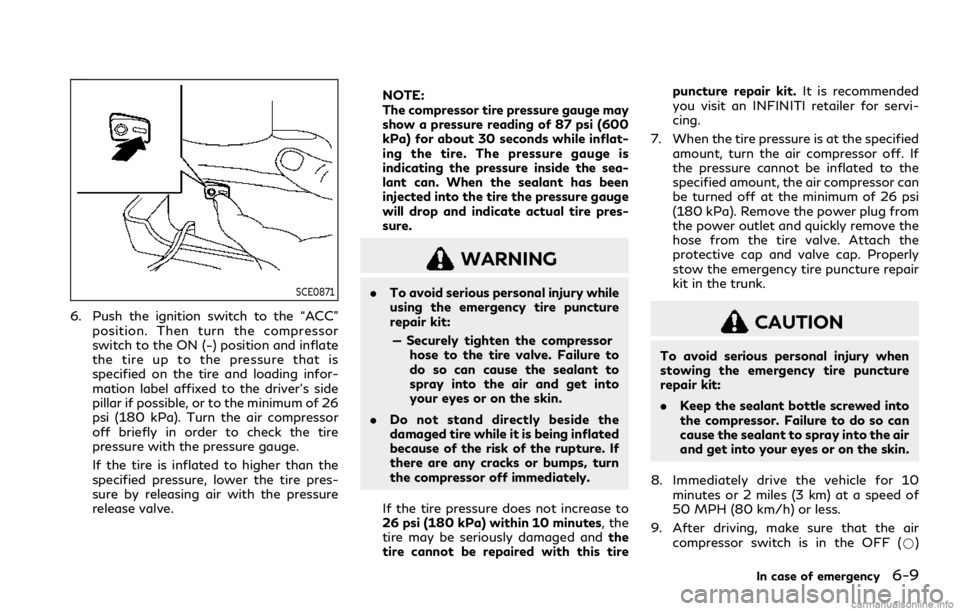
SCE0871
6. Push the ignition switch to the “ACC”
position. Then turn the compressor
switch to the ON (−) position and inflate
the tire up to the pressure that is
specified on the tire and loading infor-
mation label affixed to the driver’s side
pillar if possible, or to the minimum of 26
psi (180 kPa). Turn the air compressor
off briefly in order to check the tire
pressure with the pressure gauge.
If the tire is inflated to higher than the
specified pressure, lower the tire pres-
sure by releasing air with the pressure
release valve.NOTE:
The compressor tire pressure gauge may
show a pressure reading of 87 psi (600
kPa) for about 30 seconds while inflat-
ing the tire. The pressure gauge is
indicating the pressure inside the sea-
lant can. When the sealant has been
injected into the tire the pressure gauge
will drop and indicate actual tire pres-
sure.
WARNING
.To avoid serious personal injury while
using the emergency tire puncture
repair kit:
— Securely tighten the compressor
hose to the tire valve. Failure to
do so can cause the sealant to
spray into the air and get into
your eyes or on the skin.
.Do not stand directly beside the
damaged tire while it is being inflated
because of the risk of the rupture. If
there are any cracks or bumps, turn
the compressor off immediately.
If the tire pressure does not increase to
26 psi (180 kPa) within 10 minutes, the
tire may be seriously damaged andthe
tire cannot be repaired with this tirepuncture repair kit.It is recommended
you visit an INFINITI retailer for servi-
cing.
7. When the tire pressure is at the specified
amount, turn the air compressor off. If
the pressure cannot be inflated to the
specified amount, the air compressor can
be turned off at the minimum of 26 psi
(180 kPa). Remove the power plug from
the power outlet and quickly remove the
hose from the tire valve. Attach the
protective cap and valve cap. Properly
stow the emergency tire puncture repair
kit in the trunk.
CAUTION
To avoid serious personal injury when
stowing the emergency tire puncture
repair kit:
.Keep the sealant bottle screwed into
the compressor. Failure to do so can
cause the sealant to spray into the air
and get into your eyes or on the skin.
8. Immediately drive the vehicle for 10
minutes or 2 miles (3 km) at a speed of
50 MPH (80 km/h) or less.
9. After driving, make sure that the air
compressor switch is in the OFF (*)
In case of emergency6-9
Page 410 of 492

8-20Do-it-yourself
WAI0070X
To replace the battery:
1. Release the lock knob at the back of the
Intelligent Key and remove the mechan-
ical key.
2. Insert a flat-blade screwdriver wrapped
with a cloth into the slit of the corner and
twist it to separate the upper part fromthe lower part.
3. Replace the battery with a new one.
Recommended battery:
CR2032 or equivalent
.Do not touch the internal circuit and
electric terminals as it could cause a
malfunction.
.Hold the battery by the edges. Hold-
ing the battery across the contact
points will seriously deplete the sto-
rage capacity.
.Make sure that the + side faces the
bottom of the case.
WAI0071X
4. Align the tips of the upper and lower
parts, and then push them togetheruntil it is securely closed.
5. Operate the buttons to check its opera-
tion.
If you need any assistance for replacement,
it is recommended you visit an INFINITI
retailer for this service.
FCC Notice:
For USA
FCC ID: KR5TXN7
This device complies with Part 15 of the
FCC Rules. Operation is subject to the
following two conditions: (1) this device
may not cause harmful interference, and (2)
Page 415 of 492

SDI1679
SDI2330
Step light
SDI1258A
Trunk lightIf you have a flat tire, see “Flat tire” (P.6-3).
TIRE PRESSURE
Tire Pressure Monitoring System
(TPMS)
WARNING
Radio waves could adversely affect
electric medical equipment. Those who
use a pacemaker should contact the
electric medical equipment manufacturer
for the possible influences before use.
This vehicle is equipped with the Tire
Pressure Monitoring System (TPMS). It
monitors tire pressure of all tires except the
spare. When the low tire pressure warning
light is lit and the “Tire Pressure Low - Add
Air” warning appears in the vehicle informa-
tion display, one or more of your tires is
significantly under-inflated.
The TPMS will activate only when the
vehicle is driven at speeds above 16 MPH
(25 km/h). Also, this system may not detect
a sudden drop in tire pressure (for example a
flat tire while driving).
For more details, see “Low tire pressure
warning light” (P.2-15),“Tire Pressure Mon-
itoring System (TPMS)” (P.5-5) and “Tire
Do-it-yourself8-25
WHEELS AND TIRES
Page 420 of 492

8-30Do-it-yourself
SDI1575
Example
TIRE LABELING
Federal law requires tire manufac-
turers to place standardized informa-
tion on the sidewall of all tires. This
information identifies and describes
the fundamental characteristics of
the tire and also provides the tire
identification number (TIN) for safety
standard certification. The TIN can be
used to identify the tire in case of a
recall.
SDI1606
Example
Tire size (example: P215/60R16
94H)
1. P: The “P” indicates the tire is
designed for passenger vehicles.
(Not all tires have this informa-
tion.)
2. Three-digit number (215): This
number gives the width in milli-
meters of the tire from sidewall
edge to sidewall edge.
3. Two-digit number (60): This num-
ber, known as the aspect ratio,
gives the tire’s ratio of height towidth.
4. R: The “R” stands for radial.
F: The “F” after “R” indicates Self-
Supporting type run-flat tire.
5. Two-digit number (16): This num-
ber is the wheel or rim diameter in
inches.
6. Two- or three-digit number (94):
This number is the tire’s load index.
It is a measurement of how much
weight each tire can support. You
may not find this information on all
tires because it is not required by
law.
7. H: Tire speed rating. You should
not drive the vehicle faster than
the tire speed rating.
Page 422 of 492
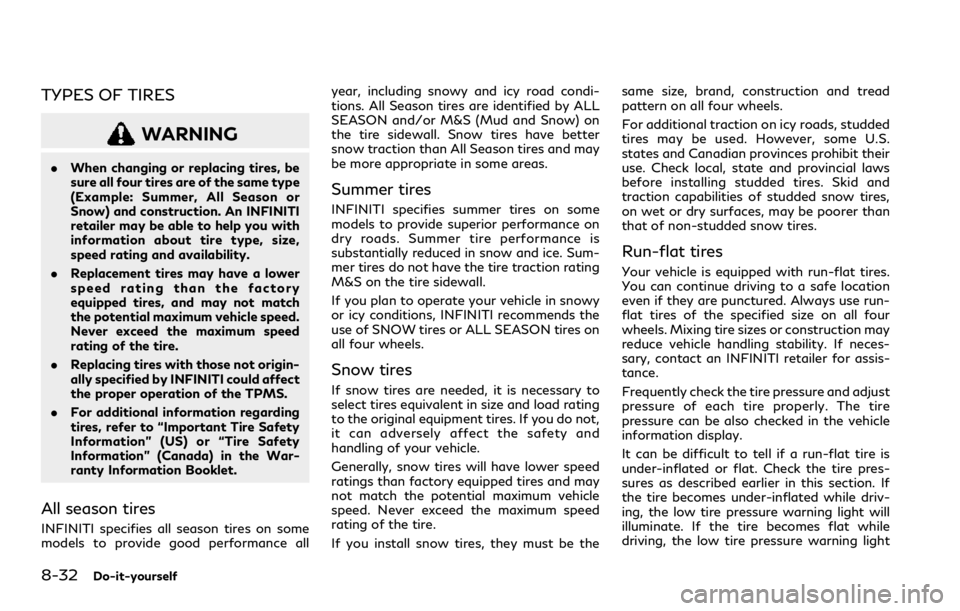
8-32Do-it-yourself
TYPES OF TIRES
WARNING
.When changing or replacing tires, be
sure all four tires are of the same type
(Example: Summer, All Season or
Snow) and construction. An INFINITI
retailer may be able to help you with
information about tire type, size,
speed rating and availability.
.Replacement tires may have a lower
speed rating than the factory
equipped tires, and may not match
the potential maximum vehicle speed.
Never exceed the maximum speed
rating of the tire.
.Replacing tires with those not origin-
ally specified by INFINITI could affect
the proper operation of the TPMS.
.For additional information regarding
tires, refer to “Important Tire Safety
Information” (US) or “Tire Safety
Information” (Canada) in the War-
ranty Information Booklet.
All season tires
INFINITI specifies all season tires on some
models to provide good performance allyear, including snowy and icy road condi-
tions. All Season tires are identified by ALL
SEASON and/or M&S (Mud and Snow) on
the tire sidewall. Snow tires have better
snow traction than All Season tires and may
be more appropriate in some areas.
Summer tires
INFINITI specifies summer tires on some
models to provide superior performance on
dry roads. Summer tire performance is
substantially reduced in snow and ice. Sum-
mer tires do not have the tire traction rating
M&S on the tire sidewall.
If you plan to operate your vehicle in snowy
or icy conditions, INFINITI recommends the
use of SNOW tires or ALL SEASON tires on
all four wheels.
Snow tires
If snow tires are needed, it is necessary to
select tires equivalent in size and load rating
to the original equipment tires. If you do not,
it can adversely affect the safety and
handling of your vehicle.
Generally, snow tires will have lower speed
ratings than factory equipped tires and may
not match the potential maximum vehicle
speed. Never exceed the maximum speed
rating of the tire.
If you install snow tires, they must be thesame size, brand, construction and tread
pattern on all four wheels.
For additional traction on icy roads, studded
tires may be used. However, some U.S.
states and Canadian provinces prohibit their
use. Check local, state and provincial laws
before installing studded tires. Skid and
traction capabilities of studded snow tires,
on wet or dry surfaces, may be poorer than
that of non-studded snow tires.
Run-flat tires
Your vehicle is equipped with run-flat tires.
You can continue driving to a safe location
even if they are punctured. Always use run-
flat tires of the specified size on all four
wheels. Mixing tire sizes or construction may
reduce vehicle handling stability. If neces-
sary, contact an INFINITI retailer for assis-
tance.
Frequently check the tire pressure and adjust
pressure of each tire properly. The tire
pressure can be also checked in the vehicle
information display.
It can be difficult to tell if a run-flat tire is
under-inflated or flat. Check the tire pres-
sures as described earlier in this section. If
the tire becomes under-inflated while driv-
ing, the low tire pressure warning light will
illuminate. If the tire becomes flat while
driving, the low tire pressure warning light
Page 423 of 492
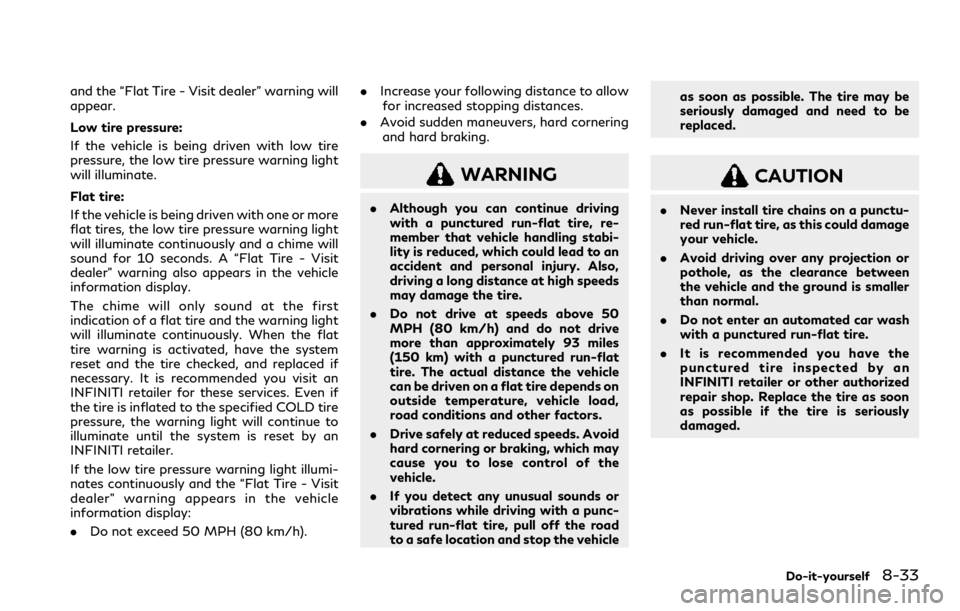
and the “Flat Tire - Visit dealer” warning will
appear.
Low tire pressure:
If the vehicle is being driven with low tire
pressure, the low tire pressure warning light
will illuminate.
Flat tire:
If the vehicle is being driven with one or more
flat tires, the low tire pressure warning light
will illuminate continuously and a chime will
sound for 10 seconds. A “Flat Tire - Visit
dealer” warning also appears in the vehicle
information display.
The chime will only sound at the first
indication of a flat tire and the warning light
will illuminate continuously. When the flat
tire warning is activated, have the system
reset and the tire checked, and replaced if
necessary. It is recommended you visit an
INFINITI retailer for these services. Even if
the tire is inflated to the specified COLD tire
pressure, the warning light will continue to
illuminate until the system is reset by an
INFINITI retailer.
If the low tire pressure warning light illumi-
nates continuously and the “Flat Tire - Visit
dealer” warning appears in the vehicle
information display:
.Do not exceed 50 MPH (80 km/h)..Increase your following distance to allow
for increased stopping distances.
.Avoid sudden maneuvers, hard cornering
and hard braking.
WARNING
.Although you can continue driving
with a punctured run-flat tire, re-
member that vehicle handling stabi-
lity is reduced, which could lead to an
accident and personal injury. Also,
driving a long distance at high speeds
may damage the tire.
.Do not drive at speeds above 50
MPH (80 km/h) and do not drive
more than approximately 93 miles
(150 km) with a punctured run-flat
tire. The actual distance the vehicle
can be driven on a flat tire depends on
outside temperature, vehicle load,
road conditions and other factors.
.Drive safely at reduced speeds. Avoid
hard cornering or braking, which may
cause you to lose control of the
vehicle.
.If you detect any unusual sounds or
vibrations while driving with a punc-
tured run-flat tire, pull off the road
to a safe location and stop the vehicleas soon as possible. The tire may be
seriously damaged and need to be
replaced.
CAUTION
.Never install tire chains on a punctu-
red run-flat tire, as this could damage
your vehicle.
.Avoid driving over any projection or
pothole, as the clearance between
the vehicle and the ground is smaller
than normal.
.Do not enter an automated car wash
with a punctured run-flat tire.
.It is recommended you have the
punctured tire inspected by an
INFINITI retailer or other authorized
repair shop. Replace the tire as soon
as possible if the tire is seriously
damaged.
Do-it-yourself8-33
Page 424 of 492
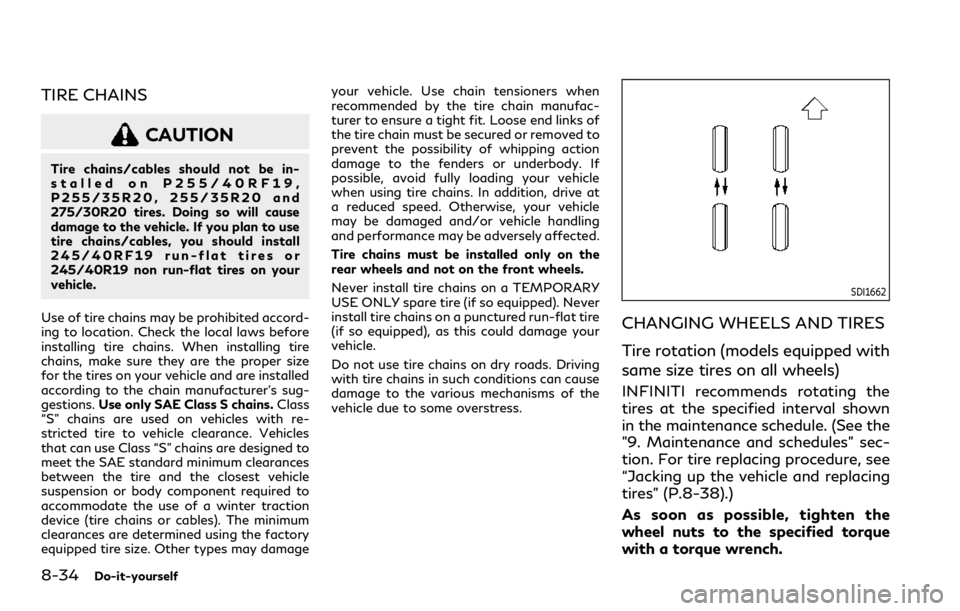
8-34Do-it-yourself
TIRE CHAINS
CAUTION
Tire chains/cables should not be in-
stalled on P255/40RF19,
P255/35R20, 255/35R20 and
275/30R20 tires. Doing so will cause
damage to the vehicle. If you plan to use
tire chains/cables, you should install
245/40RF19 run-flat tires or
245/40R19 non run-flat tires on your
vehicle.
Use of tire chains may be prohibited accord-
ing to location. Check the local laws before
installing tire chains. When installing tire
chains, make sure they are the proper size
for the tires on your vehicle and are installed
according to the chain manufacturer’s sug-
gestions.Use only SAE Class S chains.Class
“S” chains are used on vehicles with re-
stricted tire to vehicle clearance. Vehicles
that can use Class “S” chains are designed to
meet the SAE standard minimum clearances
between the tire and the closest vehicle
suspension or body component required to
accommodate the use of a winter traction
device (tire chains or cables). The minimum
clearances are determined using the factory
equipped tire size. Other types may damageyour vehicle. Use chain tensioners when
recommended by the tire chain manufac-
turer to ensure a tight fit. Loose end links of
the tire chain must be secured or removed to
prevent the possibility of whipping action
damage to the fenders or underbody. If
possible, avoid fully loading your vehicle
when using tire chains. In addition, drive at
a reduced speed. Otherwise, your vehicle
may be damaged and/or vehicle handling
and performance may be adversely affected.
Tire chains must be installed only on the
rear wheels and not on the front wheels.
Never install tire chains on a TEMPORARY
USE ONLY spare tire (if so equipped). Never
install tire chains on a punctured run-flat tire
(if so equipped), as this could damage your
vehicle.
Do not use tire chains on dry roads. Driving
with tire chains in such conditions can cause
damage to the various mechanisms of the
vehicle due to some overstress.
SDI1662
CHANGING WHEELS AND TIRES
Tire rotation (models equipped with
same size tires on all wheels)
INFINITI recommends rotating the
tires at the specified interval shown
in the maintenance schedule. (See the
"9. Maintenance and schedules" sec-
tion. For tire replacing procedure, see
“Jacking up the vehicle and replacing
tires” (P.8-38).)
As soon as possible, tighten the
wheel nuts to the specified torque
with a torque wrench.
Page 426 of 492
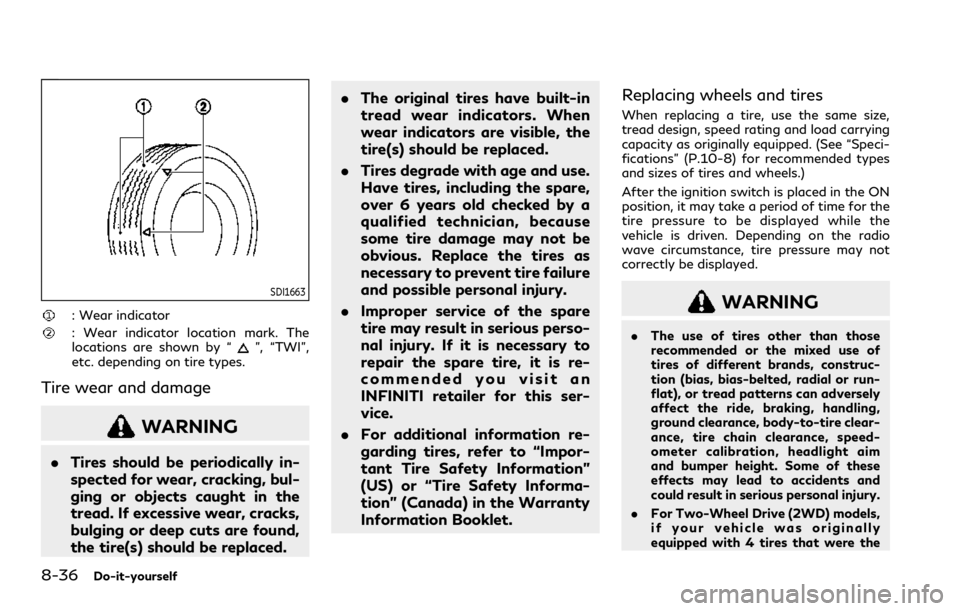
8-36Do-it-yourself
SDI1663
: Wear indicator
: Wear indicator location mark. The
locations are shown by “”, “TWI”,
etc. depending on tire types.
Tire wear and damage
WARNING
.Tires should be periodically in-
spected for wear, cracking, bul-
ging or objects caught in the
tread. If excessive wear, cracks,
bulging or deep cuts are found,
the tire(s) should be replaced..The original tires have built-in
tread wear indicators. When
wear indicators are visible, the
tire(s) should be replaced.
.Tires degrade with age and use.
Have tires, including the spare,
over 6 years old checked by a
qualified technician, because
some tire damage may not be
obvious. Replace the tires as
necessary to prevent tire failure
and possible personal injury.
.Improper service of the spare
tire may result in serious perso-
nal injury. If it is necessary to
repair the spare tire, it is re-
commended you visit an
INFINITI retailer for this ser-
vice.
.For additional information re-
garding tires, refer to “Impor-
tant Tire Safety Information”
(US) or “Tire Safety Informa-
tion” (Canada) in the Warranty
Information Booklet.
Replacing wheels and tires
When replacing a tire, use the same size,
tread design, speed rating and load carrying
capacity as originally equipped. (See “Speci-
fications” (P.10-8) for recommended types
and sizes of tires and wheels.)
After the ignition switch is placed in the ON
position, it may take a period of time for the
tire pressure to be displayed while the
vehicle is driven. Depending on the radio
wave circumstance, tire pressure may not
correctly be displayed.
WARNING
.The use of tires other than those
recommended or the mixed use of
tires of different brands, construc-
tion (bias, bias-belted, radial or run-
flat), or tread patterns can adversely
affect the ride, braking, handling,
ground clearance, body-to-tire clear-
ance, tire chain clearance, speed-
ometer calibration, headlight aim
and bumper height. Some of these
effects may lead to accidents and
could result in serious personal injury.
.For Two-Wheel Drive (2WD) models,
if your vehicle was originally
equipped with 4 tires that were the
Page 428 of 492
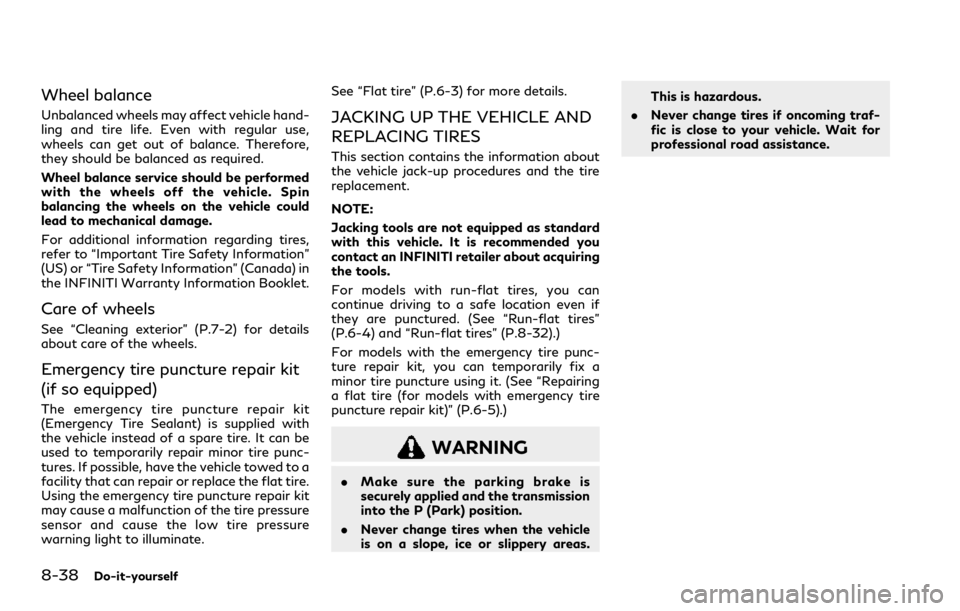
8-38Do-it-yourself
Wheel balance
Unbalanced wheels may affect vehicle hand-
ling and tire life. Even with regular use,
wheels can get out of balance. Therefore,
they should be balanced as required.
Wheel balance service should be performed
with the wheels off the vehicle. Spin
balancing the wheels on the vehicle could
lead to mechanical damage.
For additional information regarding tires,
refer to “Important Tire Safety Information”
(US) or “Tire Safety Information” (Canada) in
the INFINITI Warranty Information Booklet.
Care of wheels
See “Cleaning exterior” (P.7-2) for details
about care of the wheels.
Emergency tire puncture repair kit
(if so equipped)
The emergency tire puncture repair kit
(Emergency Tire Sealant) is supplied with
the vehicle instead of a spare tire. It can be
used to temporarily repair minor tire punc-
tures. If possible, have the vehicle towed to a
facility that can repair or replace the flat tire.
Using the emergency tire puncture repair kit
may cause a malfunction of the tire pressure
sensor and cause the low tire pressure
warning light to illuminate.See “Flat tire” (P.6-3) for more details.
JACKING UP THE VEHICLE AND
REPLACING TIRES
This section contains the information about
the vehicle jack-up procedures and the tire
replacement.
NOTE:
Jacking tools are not equipped as standard
with this vehicle. It is recommended you
contact an INFINITI retailer about acquiring
the tools.
For models with run-flat tires, you can
continue driving to a safe location even if
they are punctured. (See “Run-flat tires”
(P.6-4) and “Run-flat tires” (P.8-32).)
For models with the emergency tire punc-
ture repair kit, you can temporarily fix a
minor tire puncture using it. (See “Repairing
a flat tire (for models with emergency tire
puncture repair kit)” (P.6-5).)
WARNING
.Make sure the parking brake is
securely applied and the transmission
into the P (Park) position.
.Never change tires when the vehicle
is on a slope, ice or slippery areas.This is hazardous.
.Never change tires if oncoming traf-
fic is close to your vehicle. Wait for
professional road assistance.
Page 429 of 492
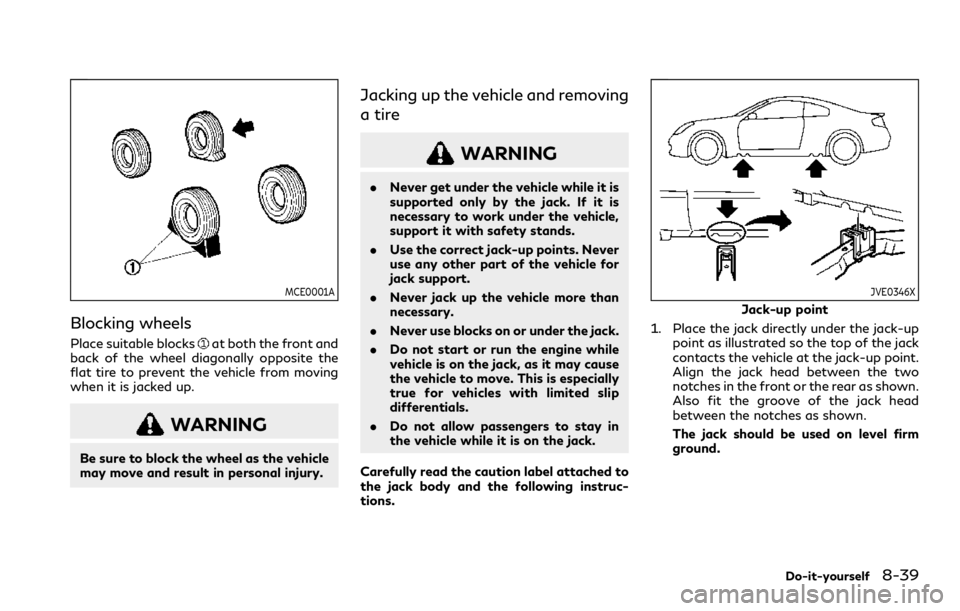
MCE0001A
Blocking wheels
Place suitable blocksat both the front and
back of the wheel diagonally opposite the
flat tire to prevent the vehicle from moving
when it is jacked up.
WARNING
Be sure to block the wheel as the vehicle
may move and result in personal injury.
Jacking up the vehicle and removing
a tire
WARNING
.Never get under the vehicle while it is
supported only by the jack. If it is
necessary to work under the vehicle,
support it with safety stands.
.Use the correct jack-up points. Never
use any other part of the vehicle for
jack support.
.Never jack up the vehicle more than
necessary.
.Never use blocks on or under the jack.
.Do not start or run the engine while
vehicle is on the jack, as it may cause
the vehicle to move. This is especially
true for vehicles with limited slip
differentials.
.Do not allow passengers to stay in
the vehicle while it is on the jack.
Carefully read the caution label attached to
the jack body and the following instruc-
tions.
JVE0346X
Jack-up point
1. Place the jack directly under the jack-up
point as illustrated so the top of the jack
contacts the vehicle at the jack-up point.
Align the jack head between the two
notches in the front or the rear as shown.
Also fit the groove of the jack head
between the notches as shown.
The jack should be used on level firm
ground.
Do-it-yourself8-39